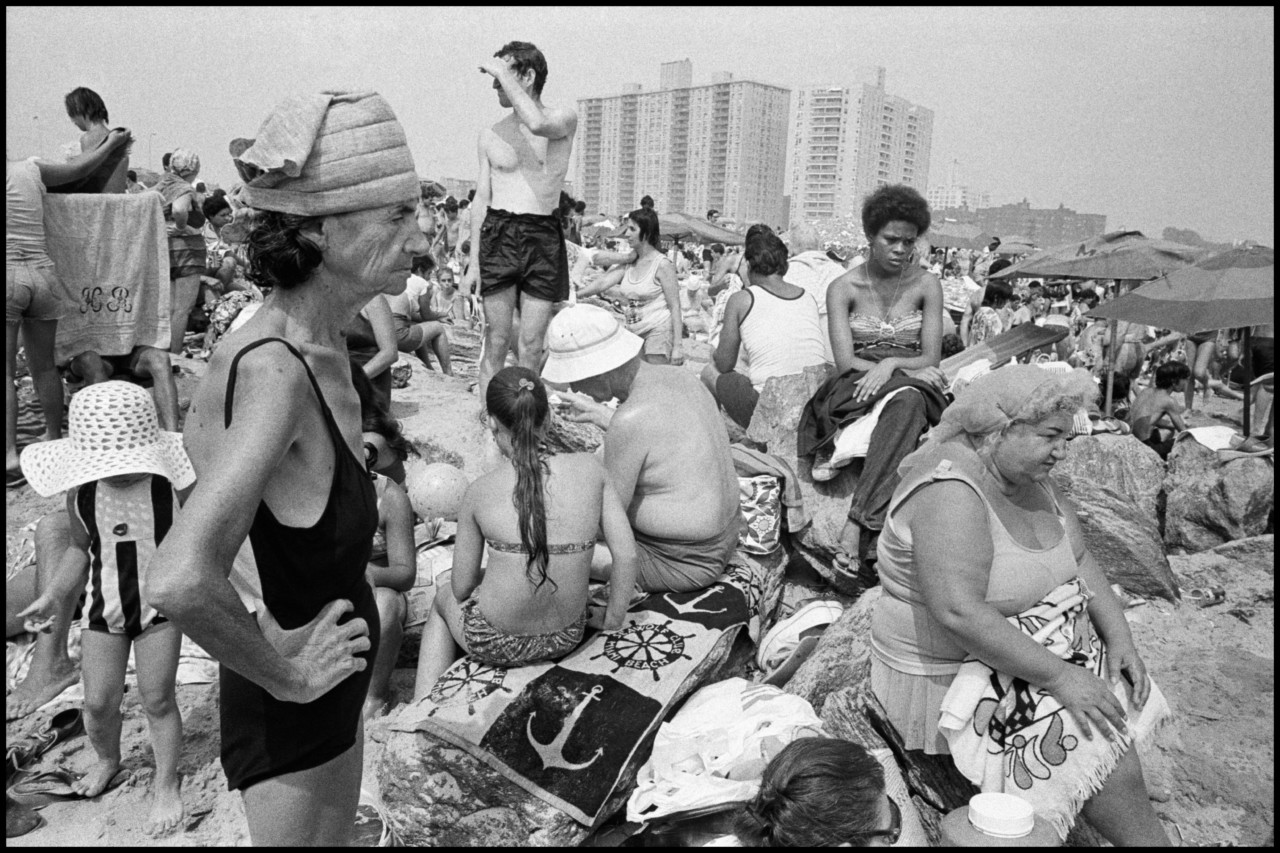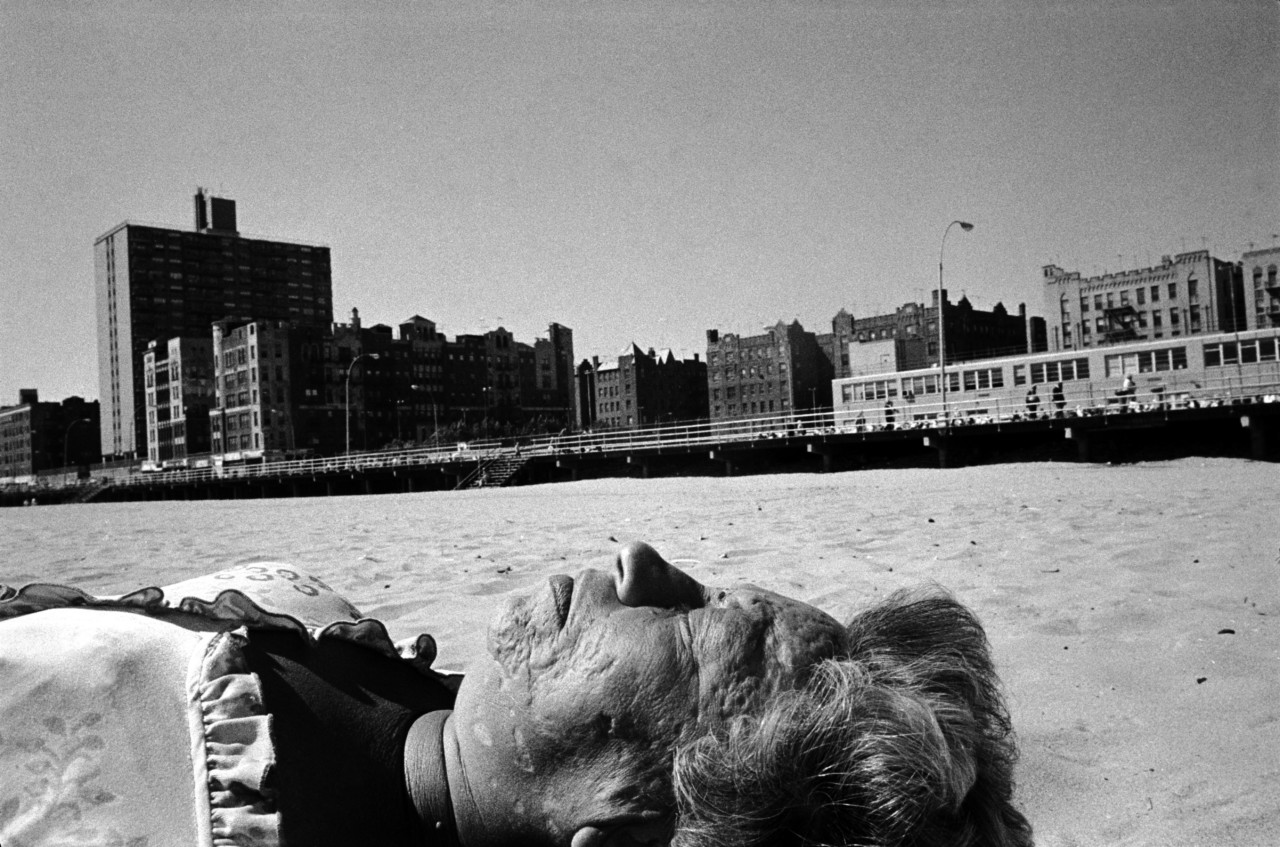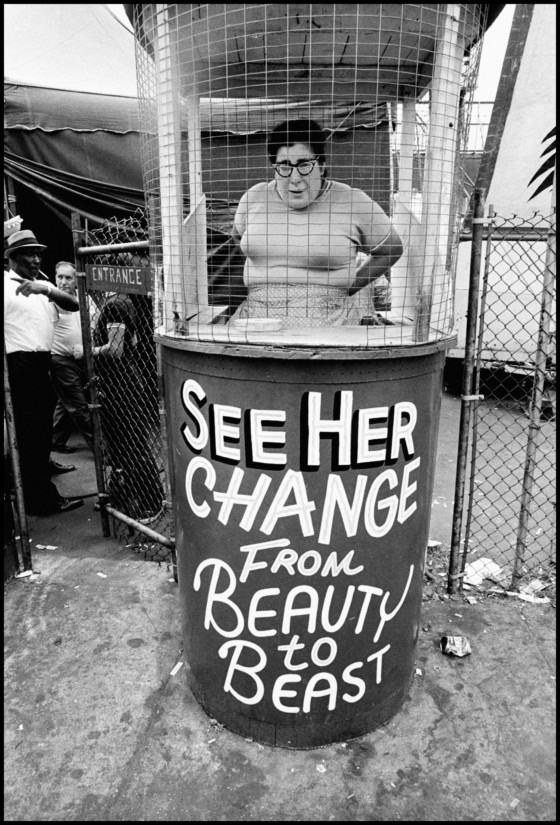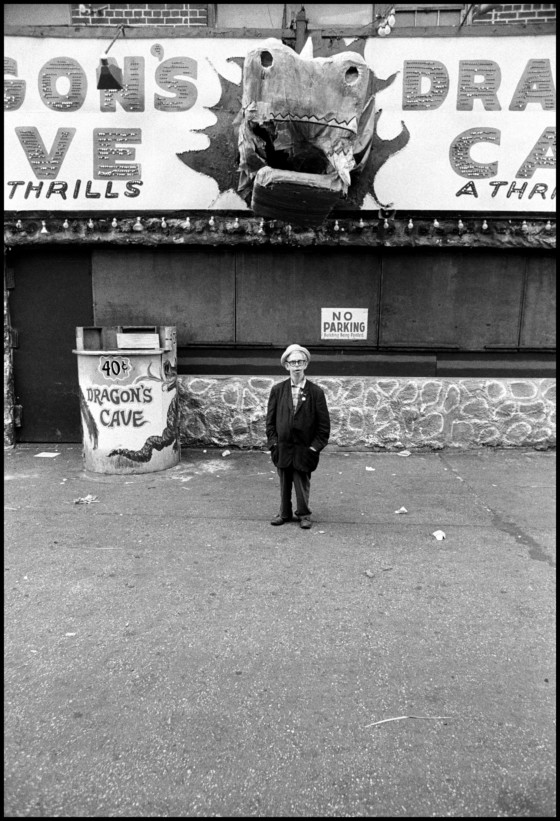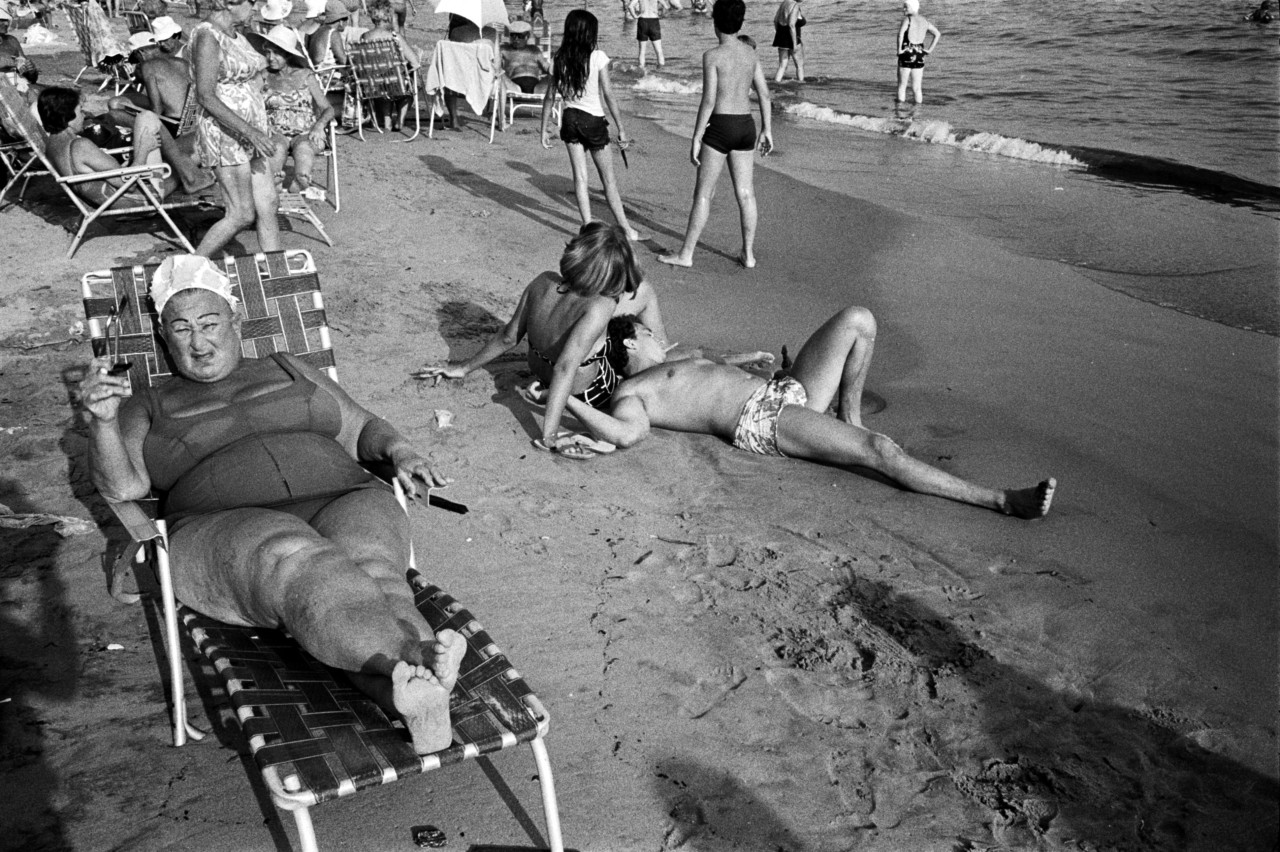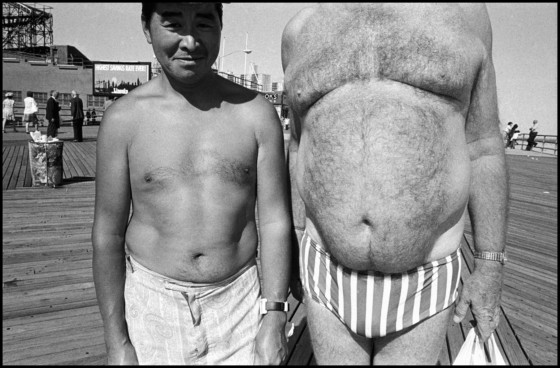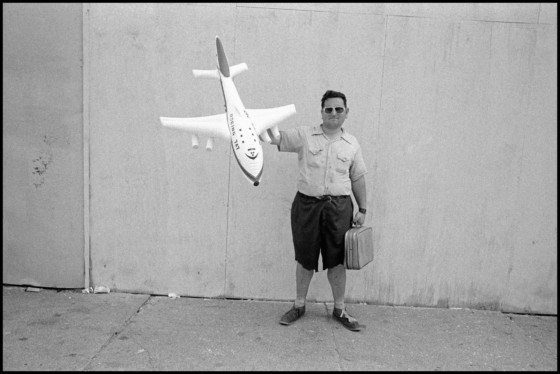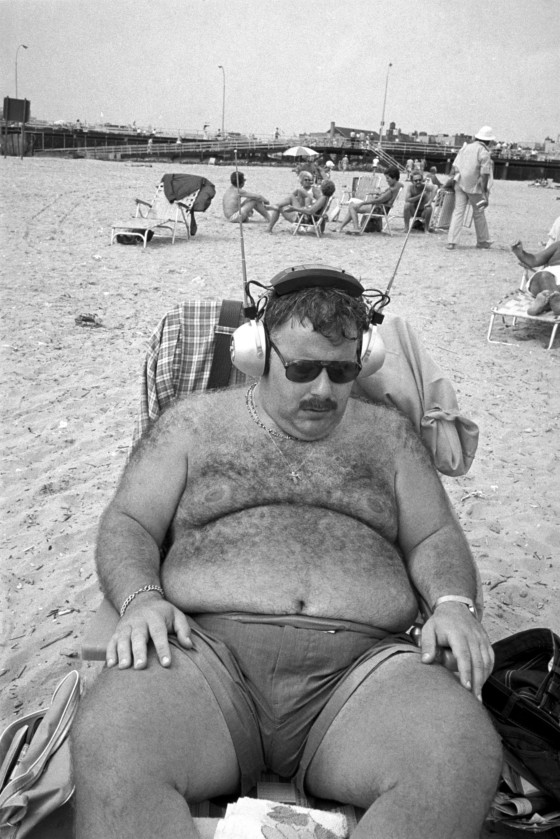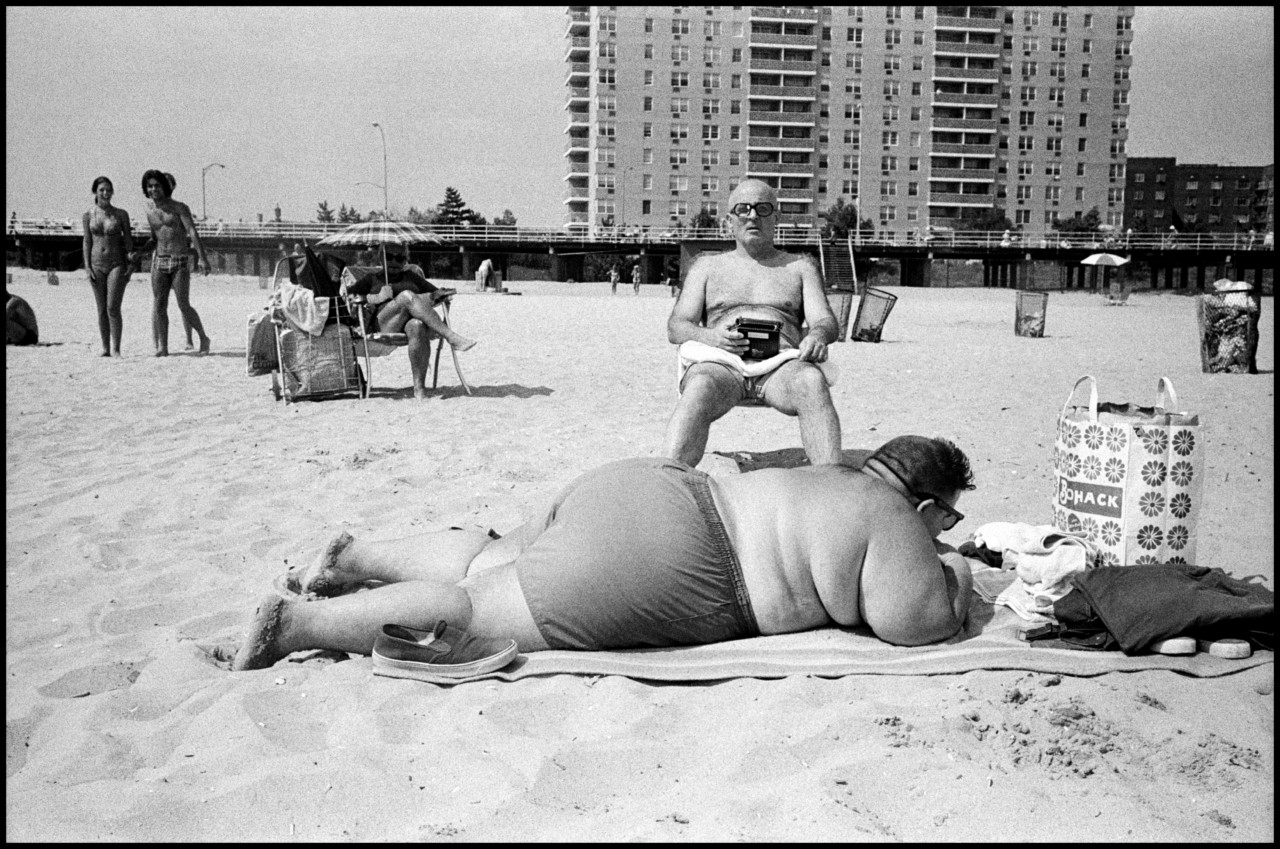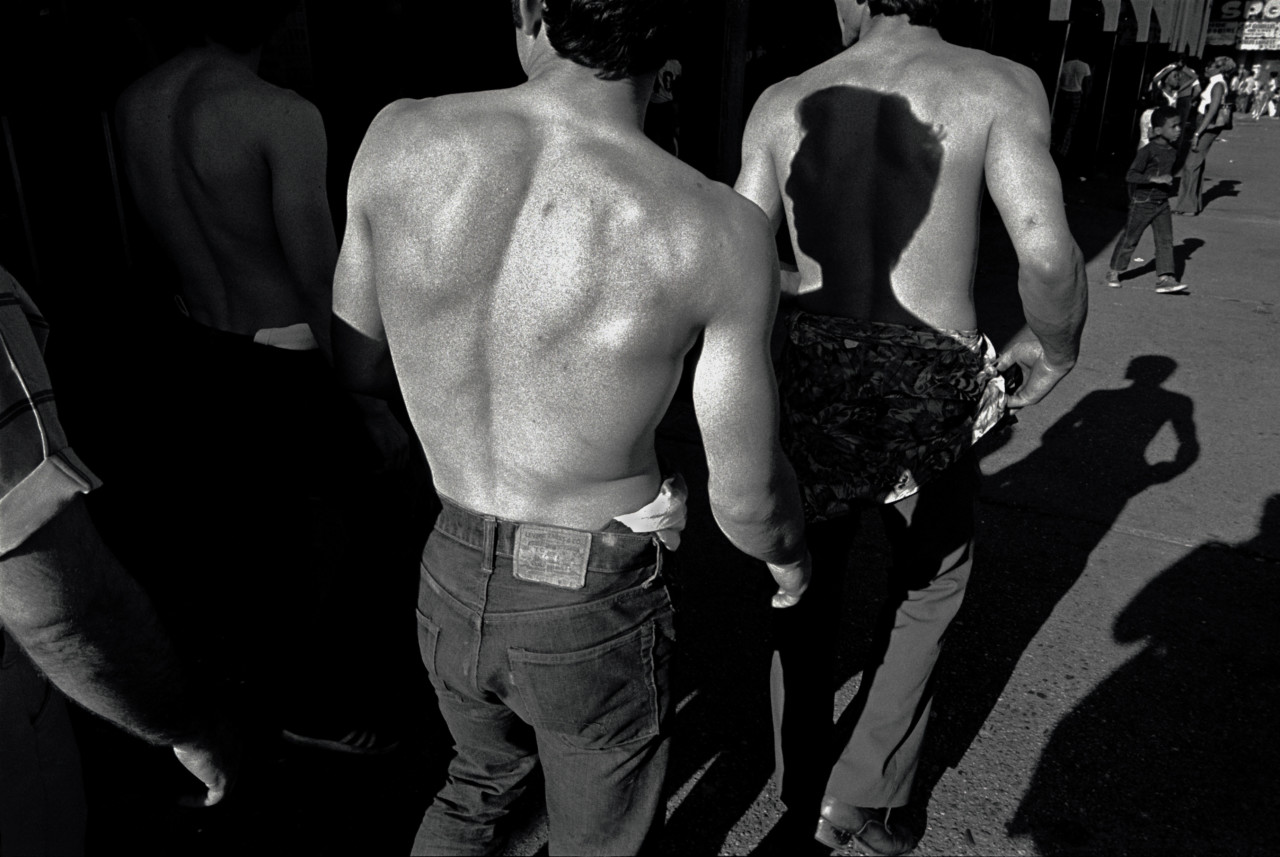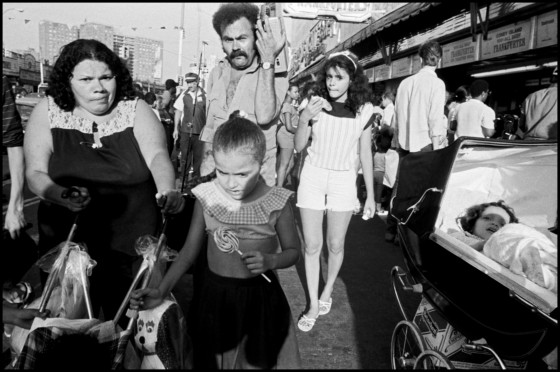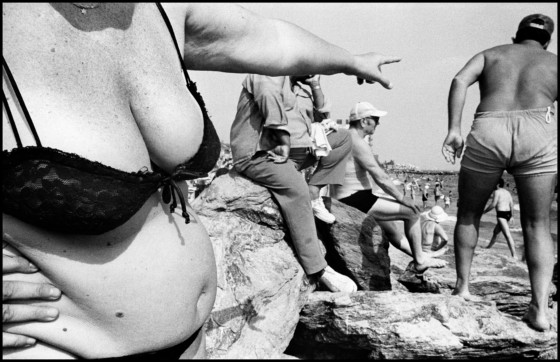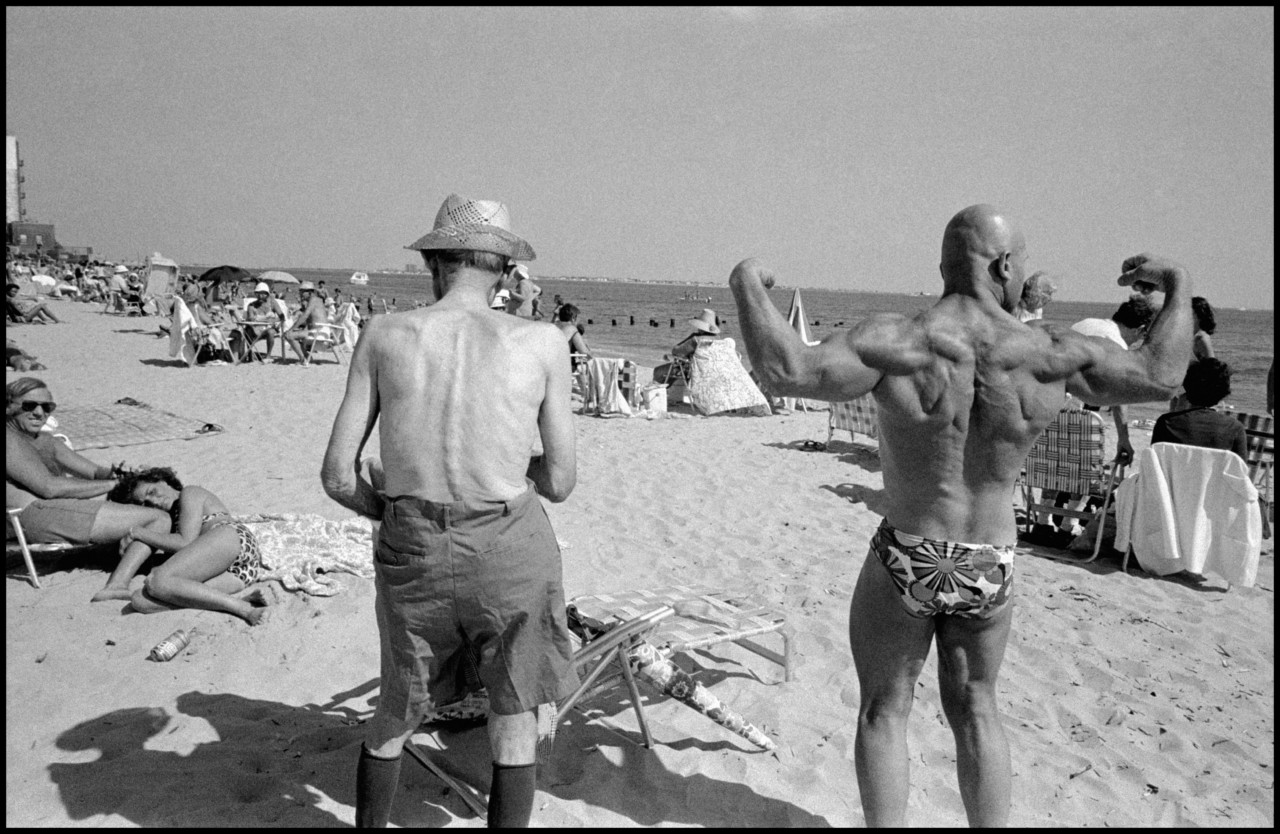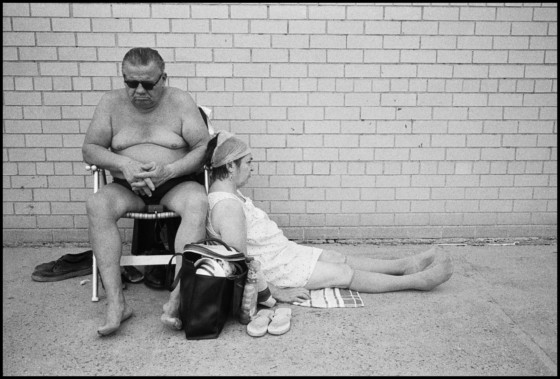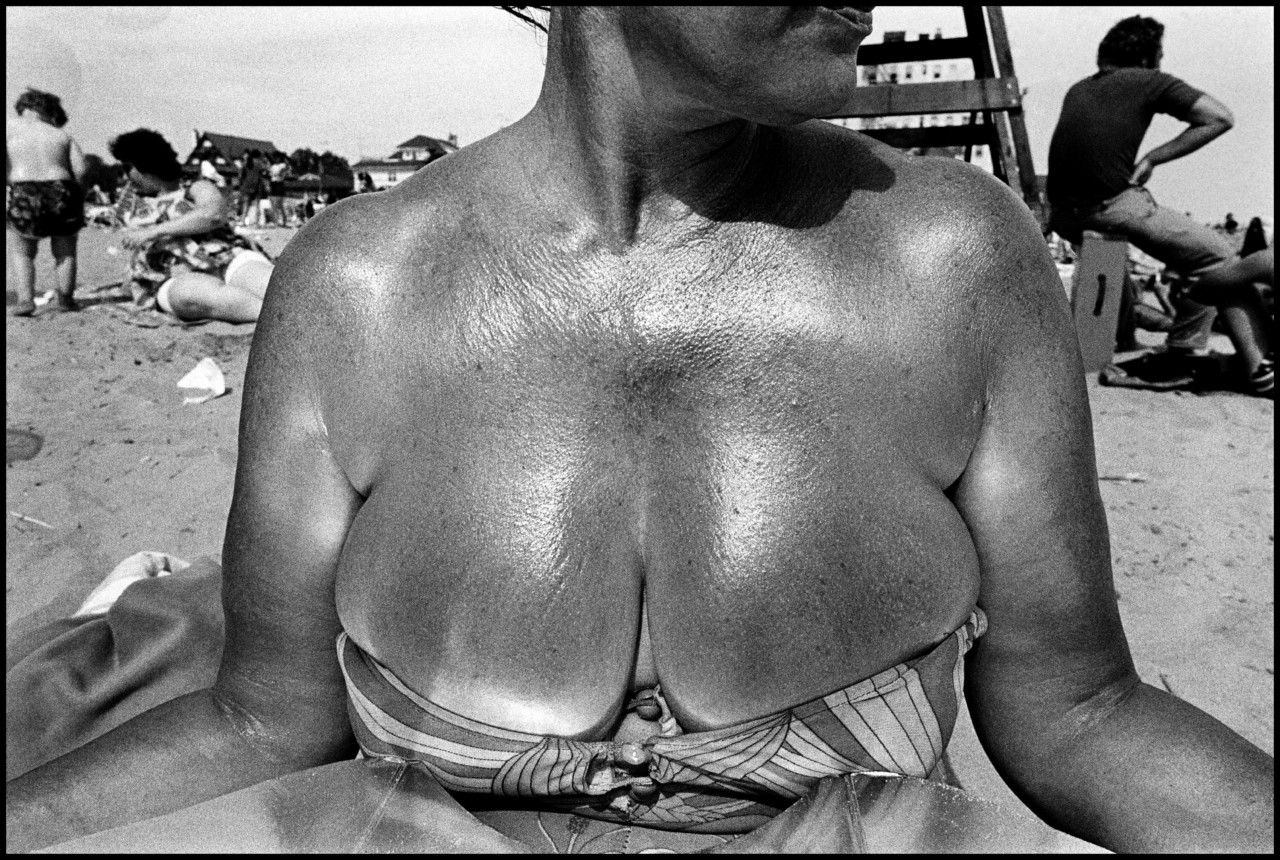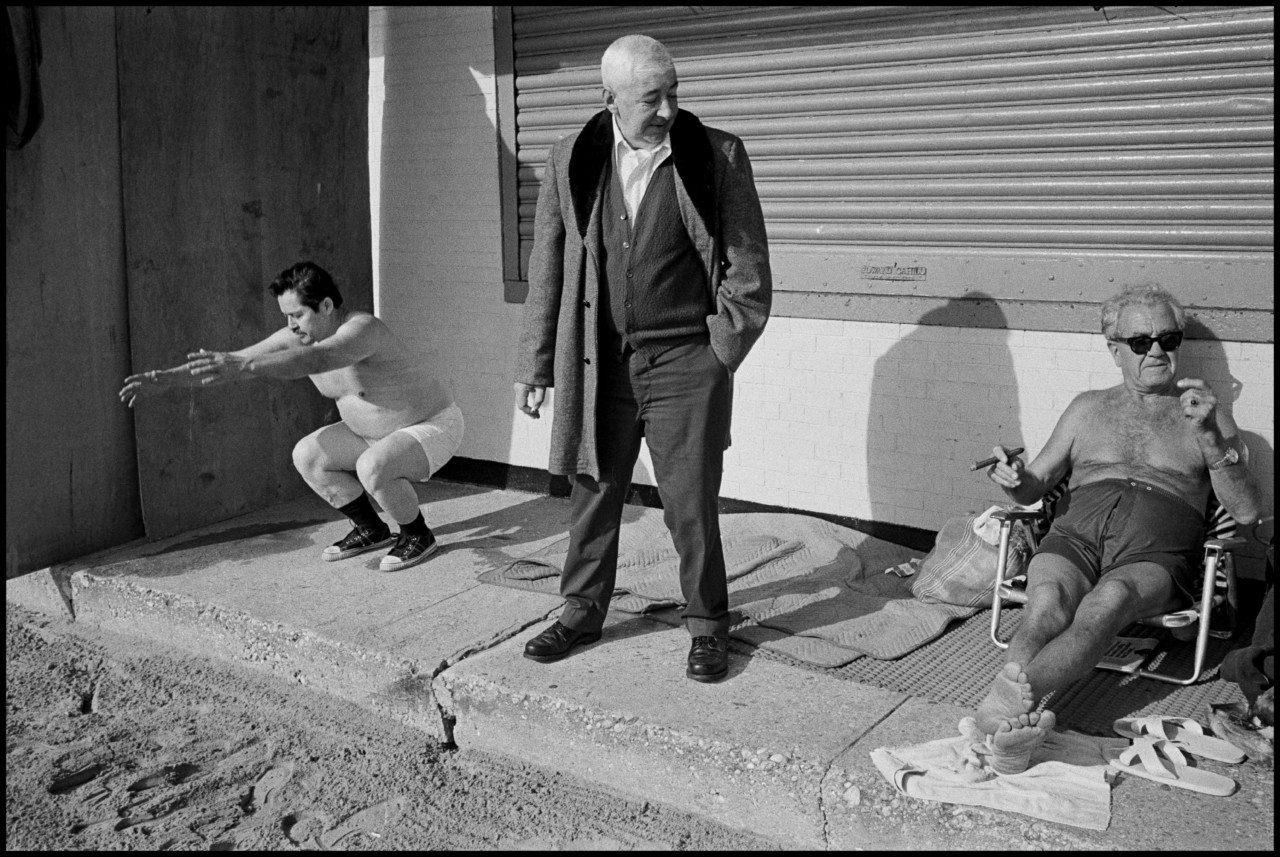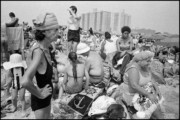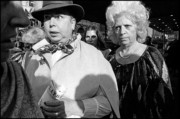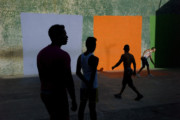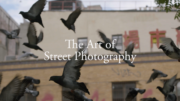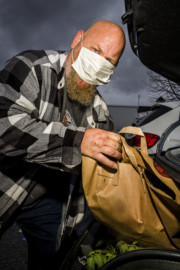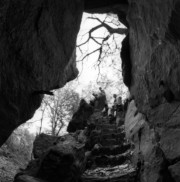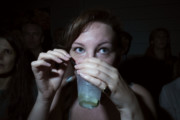Bruce Gilden’s Coney Island
Revisiting the photographer's iconic project and reflecting upon the allure of photographing New Yorkers at leisure
The first time Bruce Gilden went to shoot pictures at Coney Island, he hitchhiked there from his home in Corona, Queens, because his car had been stolen. It was 1969 and he’d only picked up his first camera a year earlier.
Clad in construction boots, long trousers, and an army jacket with long sleeves, the photographer trudged back and forth along the beach, snapping sunbathers, circus sideshows, and all manner of eccentric characters strolling along the beach, midway and boardwalk.
Back then, Coney Island – 10 miles from Manhattan, on the southern tip of Brooklyn – was already well past its 1890s heyday as the summer destination for New Yorkers, enticed by its long beach and amusement attractions like the Wonder Wheel and Cyclone rollercoaster. When Gilden was there – from the late 1960s to the late 1980s – it was more seedy, more tired, partly because of competition with other Long Island beaches, but also as the result of a series of fires, and the fact that people with money could now fly to more exotic locations.
Viewed through Gilden’s probing, witty lens, Coney Island is a place crammed with characters. Consider the man posing proudly with a huge inflatable plane, or the bespectacled woman standing behind a booth that reads SEE HER CHANGE FROM BEAUTY TO BEAST, or the small, smartly dressed man standing under a dragon’s head. Whether these characters jostle for space in the frame or appear individually, the photos themselves display a sure-footed confidence that has since come to define what we think of as ‘a Gilden picture’ – fearless, in-your-face, often humorous.
Here, as part of Magnum’s summer series: ‘Life by the Sea: Exploring identity through society at leisure and the pursuit of pleasure’, the photographer takes us back to the Coney Island of yesteryear. Gilden shares memories of a beach brimming with bathers and eccentrics, and his thoughts on how the iconic location has changed over the years.
See the rest of the stories from the series here.
Did you have some sort of routine when you were working on the Coney Island pictures?
I’d usually get there around one o’clock. I’d walk from one end of the beach – which was let’s say Coney Island, even though the beach did extend past Coney Island – all the way to the other end, which was Brighton Beach. It’s an uninterrupted stretch of beach. I was very conspicuous, wearing boots, long pants, and an army jacket. It was hard walking in the sand, and I would do two full trips: Coney Island, Brighton Beach, back to Coney Island, and back to Brighton. Then sometimes I’d even walk back to Coney Island again.
How did shooting the beach compare with the streets of New York City?
Coney Island is a lot easier to photograph than New York City because the backgrounds are cleaner and people aren’t moving. That doesn’t mean that you’ll get better pictures. It’s just easier to make a picture look good, and easier to photograph a person because they’re not moving. A lot of people are sedentary; sitting on their beach chairs. So it doesn’t test your athleticism as much.
And when I was in Coney Island it was never as crowded as it had been in the 30s, 40s, 50s, because in those days people didn’t travel as much, so since they didn’t travel they were really looking forward to a weekend at the beach. It was so packed that there was no space. Your blanket was up against someone else’s.
What is it about beach areas like this that attract so many eccentrics?
I think when you live in a place like New York City, the air is better in Coney Island, you can take a swim, it’s free, it only costs a subway ride to get out there. That’s what was part of the reason for the clientele changing there – once they put the subway in, a lot of poor people could get away. They were suffocating in the city. There was no air conditioning, they were living in tenements, it was stuffy, the air was bad, they were roasting in the hot summer. So a day at the beach was great.
Anyone who’s seen the cult movie The Warriors – which was shot at Coney Island in the 70s – might think the beach is a place populated by gangs, with regular brawls on the beach. Is there an element of lawlessness at Coney Island?
No – if people are gonna be lawless there, they’re gonna be lawless somewhere else. Maybe, years ago, I would see a fistfight. That would have been because people were drunk, so that could happen, but I don’t think people change [when they go there]. Years ago, gangs would go there, wear their colours, maybe have a fight because some other gang was there that they didn’t like. Maybe in that sense it could be a little looser there…
One time when I was very young shooting there, a black guy put his hand on my wrist and said, Give me your camera! And I said, “You must be fucking kidding me, take your hand off my fucking wrist.” If it had happened today, or if I was ten years older, I would have belted him in the face. I wouldn’t have even said a word. He wasn’t in a gang. He just thought I was a white kid that could be persuaded easily to hand over my camera. But I never really felt threatened there, ever. I don’t photograph where I’m not comfortable. And I’m about as streetwise as they come.
"I don’t photograph where I’m not comfortable. And I’m about as streetwise as they come"
- Bruce Gilden
Do you think your standing out affected your work there?
I go as I’m comfortable. I don’t try and camouflage myself, ever. But I don’t try and stand out either. On the beach people are doing what they’re doing, they’re not always paying attention to me. Like the guy trying to pick up a girl, or the person sleeping, or whatever.
For the photo of the bodybuilder standing next to the shirtless old man, I read that you asked the younger man to stand there for the shot. Did you direct many people like that?
Not too much. I did a few portraits, okay, but other than those few all the shots are candid. In the streets in New York, too, I didn’t really direct anybody, because it was about the movement, the energy. In Coney Island, if I saw somebody that I thought would make a very good portrait, I’d ask “Can you stand over here?”, that’s it. For me, you could take a staged picture and it could look like you didn’t stage it, and you could take a candid shot that looks staged. But I’m not of the ilk that you can’t ask somebody to move, because to me, I’m about getting a good photograph. That’s what counts, so if they have to move five feet, I’ll ask them to move.
"I’m very honest, I’m not playing a game where I’m trying to be 40 feet away and sneaking a picture"
- Bruce Gilden
You’ve described yourself as ‘a strong character’. How does that help you in your practice?
I think it helps me a lot. Because to take the pictures I take, you have to be tough. And I am. That doesn’t mean I’m the toughest guy on the street, but I’m tough and I know how to react. You have more trouble with weak people than you do with strong ones. But I haven’t had that many altercations for somebody who’s done what I’ve done for so long and photographed where I have. People have this weird respect for me: I’m very honest, I’m not playing a game where I’m trying to be 40 feet away and sneaking a picture. Sometimes I’m so close to people they don’t even realize I’m taking their picture. I also try to take pictures where I think the person wouldn’t mind. You know, we always make mistakes, but I don’t think things like whether you use flash or not, for example, enter into it.
How have you seen Coney Island change over the years?
It’s like New York City – it’s changed for the worse. It’s not what it was, it’s generic, it’s all cleaned up, it’s boring. That doesn’t mean somebody can’t do an okay essay on the place, because you can still find some characters there. It’s just not as interesting a place as it was. Even when I was there [for this series] it wasn’t as interesting as it had been 20 or 30 years previous. The 40s or 50s would have been a great time.
I live a few miles upstate so I don’t go there very often, but until three years ago my wife would go swimming there during the summer and I would go out, wait for her, take maybe one or two pictures. I wasn’t really interested. There are a lot more trendy people. It has lost its color, just like New York City, it’s flat. I’m not sad about it, but I do wish that there were more people around that I was interested in photographing.
"I’m about getting a good photograph. That’s what counts, so if they have to move five feet, I’ll ask them to move"
- Bruce Gilden
What’s remarkable about this project is that, one year into your career, your voice as a photographer was already there, loud and clear.
Yeah, because I knew what I wanted to photograph. It’s never changed. If you look at my career, what I’ve done is quite consistent as far as what I like and what interests me. I’ve taken strong pictures throughout my career.
Most photographers haven’t been as lucky as me. They do their best work in their first long-term project and then it’s all downhill after that. They just don’t have the passion, they don’t have the creativity. Look at a lot of photographers, you’ll see that my point is well taken.
And how do you retain that passion?
Because I’m still getting back at my father.
Browse the Life By The Sea poster and fine print collection on the Magnum Shop


